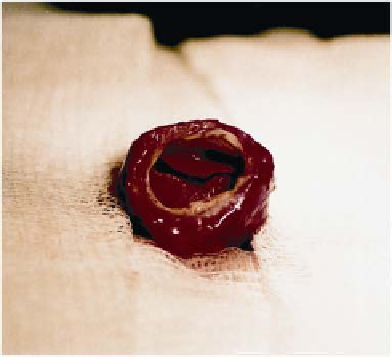Biomedical Engineering Reference
In-Depth Information
Figure 4
. Tissue-engineered valve conduit explanted after 5 weeks in vitro (70).
For a tissue-engineered organ to perform, the cells in the organ must be
interacting correctly with the other components. The tissue engineer must first
understand these interactions, and then design the organ so that the interactions
can correctly and optimally take place. The interactions can take place at a wide
range of length scales: nutrients and signals affect cells at a submicron level,
cells interact with each other and with the surrounding scaffold at the micron
level, and cells can react to mechanical stimuli that occur at the millimeter-to-
centimeter range (compare with Part III, chapter 2.1, by Huang, Sultan, and Ing-
ber, this volume). Designing and fabricating an organ requires a knowledge of
the diffusive and convective transport that puts the cells in their desired loca-
tions and circulates the signals and nutrients; transport can take place from the
micron to centimeter length scales. The final interaction of concern is that be-
tween the implant and the rest of the body, which may have effects at the centi-
meter or even meter scale.
Creation of a functional tissue-engineered organ requires an understanding
of numerous behavior at length scales from submicron up to a meter. This chap-
ter reviews some of the experimental and theoretical techniques being used over
the range of scales.
2.
TISSUE
-
ENGINEERING INVESTIGATIONS AT VARIOUS
LENGTH SCALES
This chapter surveys the field of tissue engineering, giving examples of
relevant physical behaviors. The theoretical and experimental tools used to in-


